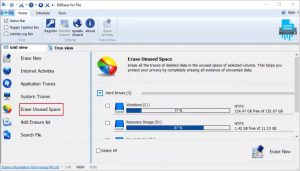The blog describes how we can completely erase your old electronic devices before discarding them.
They say change is the law of nature and to survive, we must keep adapting to the new. The same logic applies to technology. Each day new gadgets and electronic media are launched with better features and enhanced purposes. As such, we as users keep hopping from old devices to new ones frequently. But most of us take a little care to safeguard our personal data stored on an old electronic device before moving to a new one.
“We generate around 40 million tonnes of e-waste every year globally. That’s like throwing 800 laptops every second”

Why do deleting / formatting prove to be ineffective?
For a majority of users, deleting files or formatting the media seems like the best way to wipe all important data. However, what we do not know is that the data exists on the media even after we execute the delete or format command. A delete command simply erases the pointers to files thus making it impossible for the OS to locate the data. That’s why you can’t see it. But the data is very much on the device till it is overwritten with new data. Think of this as tearing off the Table of Contents from a book; you won’t know how to locate a chapter, but all chapters would still be on the book.
This is what data recovery tools take advantage of. They scout for data that still exists on the drive and provide options to recover them. Using any commercially available data recovery product, anyone with the wrong intentions can get their hands on your personal files if you’ve not made absolutely sure that you’ve wiped the device clean. Thinking on those lines, are you still convinced you’ve done enough to protect your personal or other sensitive information on your old electronic devices?
If not, the next section describes some easy and efficient ways to completely erase your device of all data.
Effective Data Erasure Techniques
Even damaged hard drives or media can contain sensitive data that can be recovered. Hence, just to be sure that your data doesn’t get into the wrong hands, it is necessary that you completely destroy it before you discard the device.
- Physical Destruction of the device

This is actually the simplest method to make sure the device cannot be used to extract important information. Physical destruction includes breaking the device apart or shredding it to small pieces using machines or mechanical shredders. Once a device is physically destroyed beyond use, no data can be recovered from it. For example, in the case of hard drives, drilling holes into the drive can physically destroy it. However you should know that physically destroying the device doesn’t imply that you are erasing data off it. It means that you’re making the device unusable for good. So this can also be seen as a disadvantage of the method. A variety of techniques can be used to physically damage electronic media, and they include disintegration, incineration, pulverization, shredding, melting, sanding, and chemical treatment.
To help you make an informed choice, here are the pros and cons of this method:
| Pros |
Cons |
| If carried out perfectly, this is the simplest and most effective way to make sure data on the device cannot be used. |
This method renders the media itself useless. It would be better to find a way to destroy only the data and reuse the device. |
| With this method, you can destroy a large amount of data (all the data on the device) in one go. |
If hard drives or other media are physically destroyed, you cannot resell it to get any compensation. Thus it is a blow to remarketing value. |
| This method can be used with any kind of media. |
Physically destroying media takes time and the debris flying from the process can pose health risks. |
|
This process usually needs to be outsourced thus compromising data security. |
- Degaussing or Magnetic destruction of recorded data
Degaussing is the process of removing all magnetically recorded data on media by applying a reverse magnetic field using machines. By returning the magnetic flux to a zero state, this method erases all content on the magnetic media. It is worthwhile to note that different magnetic media require different magnetic field strength. So if the electromagnetic field created by the degaussing machine is not strong enough for a particular media type, the process may remain incomplete. Moreover, contrary to the past when strong electromagnetic field wasn’t required for degaussing, modern hard drives use thicker shielding and thus require stronger fields.
Just as the process of physical destruction, there are several cons associated with degaussing like huge costs, unreliability, permanent destruction of the media, no guarantee of data erasure and more. Here are the pros and cons of this method:
| Pros |
Cons |
| Effective enough to destroy all data on magnetic media especially if the media requires a low electromagnetic field. |
No guarantee that one degaussing machine produces a field strong enough to destroy data on different types of media. |
| This process takes less time. |
Renders media permanently unusable |
| Can be used on a variety of media. |
The machine itself is expensive |
| Since degaussing machines can be used over and over again, once bought they usually don’t require further investment. |
This technique can only be used on magnetic media |
|
Degaussing doesn’t provide reporting of the erasure process that is needed for regulatory compliance |
- Software Overwrite
This process involves using special software to overwrite existing data with patterns of meaningless data (random combination of 1’s and 0’s). This writing is done on each sector of the hard drive 2 or 3 times to ensure that any and all existing data is thoroughly overwritten beyond recovery. The more times data is overwritten, the more the level of security.
Though reliable than the previously mentioned techniques, even software overwriting is not fool-proof. Here are its pros compared with cons:
| Pros |
Cons |
| Effective and convenient way of permanently destroying data such that media can be reused |
This technique cannot be used if the media is damaged |
| Can be performed in-house thus eliminating the risk of data theft at service center |
Freeware / Shareware tools available for this purpose might promise a lot but just be another threat to data |
| Software that perform overwriting usually generate detailed reports of the process |
|
Need of a secure data erasing software
Out of the many data erasing software available in the market, not all provide secure service. A few such tools cannot access hidden or locked areas of the hard drive such as Host Protected Areas (HPAs), remapped sectors etc. Such tools end up performing an incomplete data erasure leaving some of the data intact. So a tool that can access all areas on the hard drive and bypass BIOS and OS would be optimum to perform complete data erasure.
A recommended product that fulfills these needs is BitRaser, a data erasure. This powerful data erasing software overcomes the limitations of other techniques mentioned above and provides complete data erasure for hard drives upto 32 which boots through USB. For individuals who are concerned about their confidential files and folders and eager to wipe hard drive files and folders can try BitRaser for File, this secure file eraser software also erases system & application traces, internet activities, and unused hard drive space. You can wipe them using US Department of Defence wipe method (3 pass or 7 pass).

Final Words
Thus, making sure your electronic media is absolutely clean of data is imperative before you dispose of your old devices. Using robust and proficient software like Bitraser makes sure none of your important data gets in the wrong hands.
Was this article helpful?